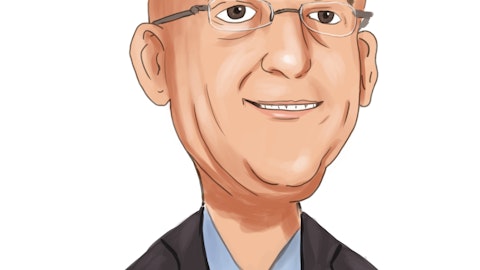Tom Lyons: I think the profitability on that business for us, Mark, is pretty strong compared to some of the sales that I’ve seen. I think we get a net margin of about 26%. So that’s really a business we want to continue to invest in and grow further.
Tony Labozzetta: With high-growth prospects.
Operator: Our next question comes from the line of Bill Young from RBC Capital Markets.
Bill Young: Just quickly on the Lakeland deal. If I recall correctly, I think the original deadline might be — for the deal might be around year-end. So has there been any discussions with Lakeland about possibly extending that merger deadline?
Tony Labozzetta: The answer is yes, but we’re hoping we don’t have to go there because we are as I mentioned in my talking points with relative to the merger, which I know is on everybody’s mind, we have provided everything that the regulators need for them to finalize their decision. And at this point, we’re waiting for their final decision. And we hope that we don’t have to be in an state in December where we’ve to consider that. But to your question is, yes, we are talking about it, and that’s under consideration.
Bill Young: Understood. And just to touch on loan growth. Can you just speak to the trends you’re seeing in multifamily. It’s been a good source of growth for you in recent quarters. Just any sense of what kind of yields you’re putting up on that? How attractive are the spreads for that business? .
Tony Labozzetta: Relative — let us look here. I think we’re still probably in that [$170 million] to over on the spreads. I would have to get back to you on that. That’s what’s coming to mind right now.
Tom Lyons: At least [$170 million to $200 million] range sense, right?
Tony Labozzetta: That’s correct. But I will tell you one of the things that just does kind of give a little bit more insight into how we’re thinking about lending. Our business model, it’s always been this, but it’s more acute today that transactions are not in high favor. A lot of it is relational oriented where we’re looking at the deposit components, insurance components and other elements as capital dollars become a little bit more — the availability of those dollars. So I think when we’re looking at the total profitability model that we run again, we put in — we drop in there the deposits and everything else that goes with it. But in general, the spread is, I would say, between [$170 million and $190 million] , I would say, is a pretty good guess.
Bill Young: Understood. And maybe lastly, just to touch on funding. I know you’ve said in the past, you’re not particularly interested in being too aggressive on promotional activity and wholesale sources kind of make sense for you right now from a price perspective, but I guess as you kind of look on to budgeting for next year, do you see kind of any need to make any changes in terms of the core deposit gathering? Do you see a need maybe kind of the change in incentive structures for bankers to kind of lean into it a little bit or to make core deposits grow more on priority?
Tony Labozzetta: Well, I think you touched on a number of things and all of that is within our thinking. But as a general direction in terms of how we’re viewing funding today, it’s still — I would still characterize it as defensive in nature, right, which is we’re paying. If you look at our cost of deposits at 1.74% and our total cost of funds at 2.04%. It’s amongst some of the best in our peer group. So we’re very cognizant not to damage that value. That being said, that’s why we use the defensive approach right now in terms of trying to maintain deposits versus being aggressive and disintermediated and having incremental cost and damaging that. That being said, we still have to grow our business. And the way we’re approaching that into the new year is, yes, we have some targeted campaigns that we think we’re not going to do that.



